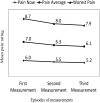Postoperative pain management among surgically treated patients in an Ethiopian hospital
- PMID: 25033399
- PMCID: PMC4102595
- DOI: 10.1371/journal.pone.0102835
Postoperative pain management among surgically treated patients in an Ethiopian hospital
Abstract
Background: Incidence of postoperative pain has been reported to be between 47-100%. Ineffective postoperative pain management results in tangible and intangible costs. The purpose of this study was to assess the processes and outcomes of pain management in the surgical wards of Jimma University Specialized Hospital, Ethiopia.
Methods and findings: A prospective cross sectional study was conducted among 252 postoperative patients during February 13 to April 30, 2012. A contextually modified and validated (Cronbach's α coefficient of 0.78) American Pain Society Patient Outcome Questionnaire was used to assess pain experience of patients. Patients' charts were reviewed to assess the pattern of analgesic use. Incidence of postoperative pain was 91.4%, and remained high over 3 measurements (McNemar's; p<0.05), and 80.1% of the patients were undertreated. The mean pain intensity, and pain interference on functional status were 6.72±1.44 and 5.61±1.13 on a 10 point Numerical rating scale respectively; both being strongly correlated(r = 0.86: p<0.001). Pain intensity was varied by ethnicity, education and preoperative information (ANOVA; P<0.05). Only 50% of the patients were adequately satisfied with their pain management. As needed (prn), solo analgesic, null analgesic, and intramuscular orders were noted for 31.3%, 89.29%, 9.7% and 20.1% of the prescription orders respectively. Though under dose, diclofenac and tramadol were the top prescribed medications, and only 57% of their dose was administered. Linear regression model showed that the predictors of satisfaction were sex of an individual and pain interference with functional status.
Conclusion: Despite patients' paradoxical high satisfaction with pain management, the majority of patients were inadequately and inappropriately treated. Thus, further research is needed to determine how best to break down current barriers to effective pain management.
Conflict of interest statement
Figures
References
-
- Marks RM, Sachar EJ (1973) Undertreatment of medical inpatients with narcotic analgesics. Ann Intern Med 78: 173–181. - PubMed
-
- Lorentzen V, Hermansen IL, Botti M (2011) A prospective analysis of pain experience, beliefs and attitudes, and pain management of a cohort of Danish surgical patients. Eur J Pain. - PubMed
-
- Stephens J, Laskin B, Pashos C, Pena B, Wong J (2003) The burden of acute postoperative pain and the potential role of the COX-2-specific inhibitors. Rheumatology (Oxford) 42 Suppl 3: iii40–52. - PubMed
-
- Lin CC (2000) Applying the American Pain Society’s QA standards to evaluate the quality of pain management among surgical, oncology, and hospice inpatients in Taiwan. Pain 87: 43–49. - PubMed
-
- Klopper H, Andersson H, Minkkinen M, Ohlsson C, Sjostrom B (2006) Strategies in assessing post operative pain–a South African study. Intensive Crit Care Nurs 22: 12–21. - PubMed
Publication types
MeSH terms
Substances
LinkOut - more resources
Full Text Sources
Other Literature Sources
Research Materials
Miscellaneous



